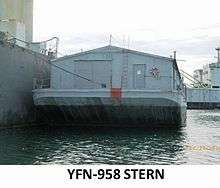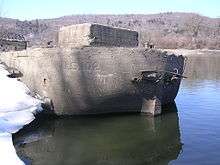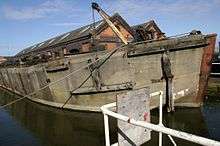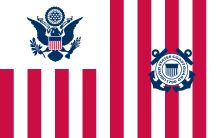Type B ship
The Type B ship is a United States Maritime Administration (MARAD) designation for World War II barges. Barges are very low cost to build, operate and move. Barges were needed to move large bulky cargo. A tug boat, some classed as Type V ships, could move a barge, then depart and move on to the next task. That meant the barge did not have to be rushed to be unloaded or loaded. Toward the end of World War 2, some ships that had not been completed in time for the war were converted to barges. US Navy barges are given the prefix: YWN or YW. Due to shortage of steel during World War II, Concrete Ship Constructors were given contracts to build concrete barges with the prefix YO, YOG, YOGN. Built in 1944 and 1945, some were named after elements, .[2][3][4][5]

World War II barge types
Steel Barge
- Built by Alabama Drydock and Shipbuilding Company in Mobile, AL, Type Coal, Design # 1039
- USSB # 301 Name Darien Barge sold to Debardeleben Marine III, Texas in 1969
- USSB # 302 Name Mamai Barge sold renamed Patricia Sheridan in 1969
- Built by Union Bridge & Construction Company in Morgan City, LA, Design #1067
- USSB #2005 Barge
- USSB #2006 Barge
- USSB #2007 Barge
- Built by Nashville Bridge Company in Nashville, TN, Design # 1096
- USSB #2776 Barge, Tank
- USSB #2777 Barge, Tank
- USSB #2778 Barge, Tank
- USSB #2779 Barge, Tank

Freight Barges -YF - YFN
Most YFN barges were not self-propelled. YF barges were self-propelled. A YFN could carry a load of 550 long tons. YFN worked near shore and had a steel hull. They worked in harbors, rivers and other protected waters. They were 110 feet long, had a 32-foot beam and maximum draft of 8 feet. The Pacific Bridge Company built 27 YFN Freight Barges in 1943: YFN 576 to YFN 603. Pollock-Stockton Shipbuilding Company built: FN 619 to FN 742 YFN 998 to YFN 1016. [6][7]
Refrigerated Freight Barges YFR - YFRN
Most YFRN Barges were not self-propelled. YFR Barges were self-propelled. Olson & Winge of Seattle WA made 10 YFRN: YFRN-833 to YFRN-841 in 1943, for the war. Defoe Shipbuilding Company of Bay City, Michigan built three: YFR-888, YFR-889 and YFR-890 in 1945. Long Beach Naval Shipyard of Long Beach, California built the YFRN-997 in 1945. A few barges were converted to refrigerated barges, also called a reefer barge.[8]
Repair Barges
.jpg)
Repair Barges type TR, YRB, YRBM, YRDH, YRDM, YRR, LBE were built for World War 2. Repair Barges were self sustaining, 530 tons and 153 feet long. Built in 1944, they had a beam of 36 feet and a draft of 6 feet. Repair Barges had a machine shop and living quarters. They repaired small boats and craft. The barge had generators, a distilling plant, an air compressor and steam boiler. The living space had berths, a mess hall to support a crew of 48 men.[9][10][11]
- Floating Workshops are YR, 96 built, 24 built before ww2
- Repair and Berthing Barges are YRB, 36 built
- Repair, Berthing and Messing Barges were YRBM, 56 built
- Dry-Dock Workshops - Hull are YRDH, 8 built
- Dry-Dock Workshops - Machinery are YRDM, 8 built
- Radiological Repair Barges are YRR, 14 built. Used to support nuclear plant overhauls of nuclear ships and submarines, also refueling and decontamination of used equipment.
- LBE Landing Barge, Emergency repair used in WW2 to repair landing crafts.
Barracks Barge
US Navy Barracks Barges, also called berthing barge was 1,300 tons and 261 feet long. They were used as a temporary barracks for sailors or other military personnel. A barracks ship also saw use as a receiving unit for sailors who needed temporary residence prior to being assigned to their ship. Barracks Barges are a type of auxiliary ship, called an APL for auxiliary personal living.[12][13]
- APB-35 to APB-51 Barracks Ships were propelled vessels built in 1944. APB had a full load displacement of 2,190 tons. APB are Benewah-class ships, a sample is USS Benewah.
- APL-1 to 58 are Non-self-propelled Barracks Ships built in 1944 and 1945. APL displaced 2,600 tons at full load. Dimensions are 261.2 feet long, 49.2 feet beam, draft 8.5 feet when fully loaded. WW2 armament was four 20mm guns. Crew quarters could accommodate 71 officers and 583 men. Some are still in use. Sample see USS Mercer (APL-39).[14]
- APL-59 to APL-72 are post WW2 Barracks Ships.[15]
Landing Barge, Kitchen
Landing Barge, Kitchen or LBK, was a landing craft used to support amphibious landings in Northwestern Europe during and after the Normandy invasion of Second World War. Its primary purpose was to provide hot meals to the crews of the many minor landing craft not fitted with galley facilities. Constructed of steel, this shallow-draft lighter had storage and serving space to feed 900 men for one week. The kitchen capacity was able to provide 1,600 hot meals and 800 cold meals a day. They were used by both the US and British on D-Day.[16][17]

Landing Barge, Vehicle
Landing Barge, Vehicle (LBV 1, mark 1) was a barge with a ramp added to load and unload vehicles like: jeeps and trucks during World War 2. A nine-foot, four-inch ramp was added to the stern for loading and unloading. LBV 2, Mark 2, had an engine that could propel the LBV at 4.5 knots. They were powered by 2 Chrysler RM Gas engines and were used by both the US and British on D-Day. Built in three sizes: small (S) 70 feet long, medium (M) 78 feet long and large (L) 82 feet long. Each had a draft of about 4 feet when loaded.[18][19]

Landing Barge, Oiler
Landing Barge, Oiler (LBO) stored fuel oil or diesel fuel for landing craft. They had a 40-ton fuel tank, with two compartments and an engine that could propel them at 4.5 knots. They were used by both the US and British on D-Day.[20][21][22]
Landing Barge, Water
Landing Barge, Water (LBW) a barge with a 33-ton fresh water tank and an engine that could propel them at 4.5 knots. They were World War 2 landing support vessels. Used by both the US and British on D-Day.[23]
Landing Barge, Flak
Landing Barge, Flak (LBF) a Landing Barge with a 40mm anti-aircraft gun, manned by a crew of five. Also had Two 20-mm Hispano AA guns or two twin Lewis guns. The LBF were 60 to 90 feet long. They could transport 15 troops. Used by both the US and British on D-Day.[24][25]
Concrete Barge
- Built by Concrete Ship Constructors in National City, California in 1944 and 1945. These were a type of concrete ship. Steel shortages led the US military to order the construction of small fleets of ocean-going concrete barge and ships. Typical Displacement: 5,636 long tons (5,726 t), full load: 12,910 tons. Length:366 ft 4 in (111.66 m), beam: 54 ft (16 m), draft: 26 ft (7.9 m), crew 52 officers and men. Ship armament 1 to 4 40 mm AA gun[26][27][28][29] Concrete Ships were fitted as needed. Some had diesel-electric power generators for refrigeration or tool use. Others were used to store fuel or water (up to 60,000 barrels). Some were used for water distilling. Others were the Quartermaster general store.[30]
- Type MC B7-A2 tank barges made by Concrete Ship Constructors Inc in National City CA.
B7-A2 were 5,786 deadweight tons concrete barges.
- YOGN-42 Sunk by Japanese submarine I-39[31]

- YOG-85
- YO-144
- YOG-40
- YOG-41
- YOG-42
- YO-145
- YO-146 Sank in accident July 1957
- YOG-53
- YO-159 Sank by Japanese submarine RO-42 off New Hebrides 14 Jan 1944
- YO-160 Atomic bomb test at Bikini Atoll on 25 Jul 1946
- YO-161 Sank Eniwetok 29 Nov 1946
- YO-162
- YO-163
- YO-182
- YO-183
- YOGN-82 Sunk on June 23, 2018 to form an artificial reef in Powell River, B.C.[32]
- YO-184 Sank at Eniwetok during typhoon Sep. of 1946
- YO-185 Sank off Saipan 16 March 1946.
- YOG-83 Sank in off Kwajalein 16 Sep. 1948.
- YO-186 Sank at sea off Guam 5 April 1948.
- YO-187 Lost by grounding off Midway Island in 1957
- YOG-84 Lost during typhoon at sea off Saipan 14 Nov 1948
Type B5-BJ1 were covered dry cargo barges. They were 265 feet long with a deadweight of 1,632 tons.

- Barium
- Helium
- Nitrogen
- Radium
- Argon
- Cadmium
- Chromium
- Cobalt
- Iridium
- Lithium
- Magnesium
- Neon
- Nickel
- Phosphorus
- Sodium
- Sulphur
- Tellurium
- Tungsten
- Uranium
- Bismuth
- Bromide
- Hydrogen with reefer storage
- Calcium with reefer storage
- Antimony with reefer storage
- Cerium maintenance barges
- Radon maintenance barges
- YOGN 104 built by Alabama Dry Dock Mobile AL Ex-C 105, disposed of 1947
- 1950s Built by Trinity Industries in Nashville TN, 165 feet long, 245 tons.
- YOGN-110
- YOGN-111
- YOGN-112
- YOGN-113
- Built by Albina Engine & Machine in Portland OR, 165 feet long, 245 tons.
- YOGN-114
- YOGN-115 used to support cooling efforts at the Fukushima Daiichi nuclear power [33][34]
- YOGN-116
- YOGN-117
- YOGN-118
- YOGN-119 renamed YON 367, sunk as target 1973
- YOGN-120 renamed Ex-BG 1165, sunk as target 1978
- YOGN-121
- YOGN-122 Ex-BG 8452, scrapped 1986
- YOGN-123 Ex-BG 6380, YON 252
- YOGN-124 Ex-BG 6383, struck 2006
- YOGN-125 Ex-YWN 154, now YON
- Built by Manitowoc SB in Manitowoc WI, 174 feet long, 440 tons.
- YOGN-196 renamed Ex-YO 196, sunk as target 2000
Trefoil-class concrete barge
Type: B7-D1 were built by Barrett & Hilp in South San Francisco, California. They had a tonnage of M.C. Deadweight: 5,687, Full Load: 10,970 pounds.
Dimensions: Length: 366'4" by Beam: 54' with max. Draft: 26'

- Trefoil
- Quartz
- Silica
- Carmita (ex-Slate)
- Asphalt
- Bauxite
- Limestone
- Feldspar
- Marl
- Barite
- Lignite
- Cinnabar
- Corundum
B7-A1 B7-A1 were 5,786 deadweight tons concrete barges.
- MacEvoy Shipbuilding Corp. of Savannah, Georgia made seven B7-A1 concrete barges in 1944.
- San Jacinto Shipbuilding Corp. of Houston TX made four B7-A1 concrete barges in 1943.
C1-S-D1 C1-S-D1 were made by McCloskey & Company in Hookers Point, Tampa, Florida in 1944. McCloskey built 24 C1-S-D1. Many were sunk after the as war as breakwater barriers. B7-A1 were 5,004 deadweight tons concrete barges. Name - Completed - Fate
- Vitruvius Dec-43 Sunk as a breakwater at Normandy
- David O. Saylor Nov-43 Sunk as a breakwater at Normandy
- Arthur Newell Talbot Feb-44 Sunk as a breakwater at Kiptopeke VA
- Richard Lewis Humphrey Mar-44 Sold in Mexico
- Richard Kidder Meade Mar-44 Sunk as a breakwater at Kiptopeke VA
- Willis A. Slater Feb-44 Sunk as a breakwater at Kiptopeke VA
- Leonard Chase Watson Jun-44 Sunk as a breakwater at Kiptopeke VA
- John Smeaton Apr-44 Afloat as a breakwater at Powell River BC
- Joseph Aspdin May-44 Wrecked and lost 1948
- John Grant Jun-44 Sunk as a breakwater at Kiptopeke VA
- M. H. Le Chatelier 1055 Jul-44 Afloat as a breakwater at Powell River BC
- L. J. Vicat Jul-44 Afloat as a breakwater at Powell River BC
- Robert Whitman Lesley 1057 Jul-44 Sunk as a breakwater at Kiptopeke VA
- Edwin Thacher Jul-44 Sunk as a breakwater at Kiptopeke VA
- C. W. Pasley Aug-44 Sunk as a breakwater at Newport OR
- Armand Considere Sep-44 Afloat as a breakwater at Powell River BC
- Francois Hennebique Sep-44 Sunk as a breakwater at Newport OR
- P. M. Anderson Sep-44 Afloat as a breakwater at Powell River BC
- Albert Kahn Oct-44 Abandoned and lost 1947
- Willard A. Pollard Nov-44 Sunk as a breakwater at Kiptopeke VA
- William Foster Cowham Nov-44 Sunk as a breakwater at Kiptopeke VA
- Edwin Clarence Eckel Dec-44 Scuttled 1946
- Thaddeus Merriman Nov-44 Afloat as a breakwater at Powell River BC
- Emile N. Vidal Dec-44 Afloat as a breakwater at Powell River BC
Wood Barge
- Built by American Lumber in Millville, Florida
- Millville EFC # 2432 USSB Design #1067
- Built by Beaumont Shipbuilder & Dry Dock in Beaumont, TX,
- Shelbank EFC #2127 later completed as sailing ship Marie F. Cummins, scrapped in 1947
- Shelby EFC #2128 ater completed as sailing ship Albert D. Cummins, scrapped 1947
- Built by Coastwise Shipbuilder in Baltimore, MD
- Catonsville EFC #2141
- Sherwood EFC #2142
- Carroll EFC #2143
- Built by Cobb & Company, F. in Rockland, ME
- Whitehead EFC #2481
- Built by Crook, H. E. Baltimore MD
- Druid Hill EFC #2594
- Ruxton EFC #2595
- Built by Crosby Navigation in Richmond, VA
- Hallowell EFC #2577
- Richmond EFC #2578
World War I barge types
Many World War I barges were used in World War II, due to the high demand.
Steel
- Built by American Steel Barge Company in Superior, WI, from 1891 to 1945.[35][36]
- YW , YW-1 to YW-132, Water Barge self-propelled
- Water Barge non-self-propelled
- YWN-145 (was YW-145)
- YWN-146 (was YW-146)
- YWN-147
- YWN-148 ex YON-187
- YW-149
- YW-150
- YW-151
- YW-152
- YWN-153
- YWN-154
- YW-155
- *YWN-156 ex YOGN-116
- YWN-157 ex YOG-32
Wood
- Built by Anacortes Shipways in Anacortes, WA in 1918 [37]
- USSB Barden type# 1001, LDT 2,551,
- USSB Dacula type# 1001, LDT 2,551,
- USSB Western Larch I type# B5-G1
- USSB Western Larch II type# B5-G1
- USSB Western Larch III type# B5-G1
- Built by Allen Shipbuilding in Seattle, WA in 1919, Design # 1115[38]
- USSB Allenhurst type 1115
- USSB Ahmik type 1115
- Built by Coastwise Shipbuilding in Baltimore MD in 1919, design # 1067
- USSB Sherwood
- USSB Catonsville
- USSB Carroll
- Built by Crook, H. E. in Baltimore MD, design # 1067
- USSB Druid Hill (1919)
- USSB Ruxton (1920)
- Built by Crosby Navigation in Richmond VA, design # 1067
- USSB Hallowell
- Built by Gildersleeve Shipbuilding in Gildersleeve, CT, Coal Barge, design#115
- USSB YC 600
- USSB YC 601
- USSB YC 602
- Built by Johnson Shipyards in Mariners Harbor, NY, 1919, design#1067
- USSB Tompkinsville
- Built by Machias Shipbuilding in Machias, ME, 1919, design#1067
- USSB Wellesley
- USSB Jonesport
- Built by McEachern Shipbuilding in Astoria, OR, 1920
- USSB Cabria
- Built by Meacham & Babcock in Seattle WA, 1919, design#1001
- USSB Chalois
- USSB Charnis
- Built by Midland Bridge in Houston, TX, 1919, design#1067
- USSB Aransas
- USSB Matagorda
- Built by Sloan Shipyards in Anacortes, WA, 1918, design#1001
- USSB Cabacan
- USSB Dacula
- Built by . Johns River Shipyard Co. in Jacksonville, FL, 1919, design#1067
- USSB Anastasia
- USSB Daytona
- USSB Ormond
- Built by Tacoma Shipbuilding in Tacoma, WA, 1918, design#1001
- USSB Dione
- Built by Wright Shipyards in Tacoma WA, 1918, design#1001
- USSB Endymeon
Concrete

Concrete Barges were used in WW1. Louis L. Brown built concrete barges at Verplank, New York.[39]
- YC-516 - Barge # 1 (Coal Barge #516), built 1918.[40][41]
- YC-442 - Barge # 442 - Built 1918, displacement 922 tons.[42]
- For WW1 12 emergency fleet concrete barges were ordered for the war, but they were not completed in time and were sold to private companies.[43]
(12 Concrete ships were also built, like the SS Atlantus.)
Notable incidents
- YOG 42, Gasoline barge. Under tow by Navajo - AT64, when Navajo was torpedoed and sank by Japanese submarine I-39 on 12 September 1943, 150 miles East of Espiritu Santo. Recovered by USS Sioux (AT-75).[44]
- YO-64 Sank due to enemy action in the Philippine in January 1942.[45]
- YOG 41, YOG 42 and YOG 43 Gasoline barges. Sank 22 Feb 1942 during enemy action in the Philippines.[46]
- YSP- 44, YSP- 46, YSP- 47, YSP- 48, YSP- 49 Salvage barges and the YSR-2, a sludge barge, sank 22 Feb. 1942 during enemy action in the Philippines.[47]
- YW-50, YW-50 and YW-50 Water barges, Sank 24 July 1942 in enemy action in the Philippines.
- YC-891 Sank on 18 April 1945, while under tow by the tug Mauvila (YT-328) off Key West, Florida.
- USS YOG-76 Sank on 13 November 1969 in Cua Viet Cove, South Vietnam after two underwater explosions hit her. Refloated and taken to Da Nang, South Vietnam. Not repaired due to severe damage.[48]
- Syncline YO-63 A Bullwheel Class Fuel Oil Barge, Self-propelled, sank in 1972 north of Tahiti.[49]
- YW-114 A YW-83 Class Self-propelled Water Barge. Sank when cargo shifted at Tongass Narrows near Ketchikan, Alaska on 12 August 1989.[50]
- YF-1079 Ran aground and damaged at Buckner Bay, Okinawa, after Typhoon Louise in October 1945. YF-757 also sank in the storm.
- YON-184 Sank at Eniwetok in a typhoon in September 1946.[51]
- Winifred Sheridan A sea-going coal barge. Sank with the Mary E. O’Hara a sailing fishing ship after they collided on January 20, 1941 in blinding snowstorm off The Graves Light.[52]
- Chickamauga While under tow by the steamer Samuel Mitchell, she collided with the Mitchell at Houghton Point, Lake Superior on May 18, 1908 in fog.[53]
- Dunaj 2 Sank after striking a mine in the Sea of Azov on 29 Sep 1943.[54]
- YC21 Sank in a storm on 15 November 1968.[55]
- Allegheny Shelled and sunk in the Atlantic Ocean 9.5 nautical miles (17.6 km) east south east of the Metopkin Inlet, Virginia (37°34′N 75°25′W) by U-boat U-754. All three crewmembers were rescued by USCGC CG-4345 (

- YCK-8 Wooden barge sank 2.7 miles off Key West, Florida on 12 December 1943. She was under tow by Army tug LT-4.[57]
- USS YO-159 A self-propelled fuel oil barge. Torpedoed and damaged 250 nautical miles (460 km) east of Espiritu Santo (15°27′S 171°28′E) by Ro-42. Two torpedoes hit YO-159's concrete hull, causing the loss of her fuel oil cargo which caught fire. She was scuttled the following day by USS PC-1138.[58][59]
- USS Asphalt (IX-153) An S class Trefoil concrete barge was wrecked at Saipan, Northern Mariana Islands in a storm.[60]
- USS YO-156 and USS YO-157 World War II self-propelled fuel oil barges. Lost at Sitka, Alaska in May 1945.
- USS Silica An S class Trefoil concrete barge. Ran aground on 9 October 1945 during a Typhoon Louise off Okinawa.[61]
- YON-160 Sank in Operation Crossroads. The fuel oil barge was sunk as a target by an atomic bomb at Bikini Atoll on 25 July 1946.
- USS Lignite (IX-162) Wrecked by a typhoon, 9 October 1945.[62]
- YC-442, Barge # 442 sank 11 September 1923.[63]
United Kingdom
- Thames lighters, or dumb barges, were non-self-propelled barges. The original Thames barges were sailing vessels, many were converted for the war. Some LB vessels had ramps added and were called LBR or Landing Barge, Ramped. Some had engines and rudder added and were referred to as LBV or Landing Barge Vehicle. They were used for different tasks: Landing Barge Oiler (LBO), Water (LBW), Kitchen (LBK) and Emergency Repair (LBE), Landing Barge Flak (LBF) and Gun (LBG). There was also one Landing Barge Cable (LBC). Many brought supplies to Normandy.[64][65]
Current barge classes
Type B I barge hull. Designed to ensure no uncontrolled release of cargo to the water or atmosphere.
Type B II barge hull. Designed to carry products which require substantial preventive measures to ensure no uncontrolled release of cargo to the water or atmosphere, but only of the release does not constitute a long term hazard.
Type B III barge hull. Designed to transport products classed as minor hazards, thus needing less degree of control.[66]
See also
References
- navsource.org YW-59
- militarymuseum.org, Concrete Ship Constructors
- shipbuildinghistory.com, Merchant Ships Barge
- Wooden Ships and Barges
- navsource.org, YC, Open Lighter (Non Self-propelled) bardges
- globalsecurity.org YFN - Steel Covered Lighter
- shipbuildinghistory.com Freight Barges (YF, YFN) and Refrigerated Freight Barges (YFR, YFRN) Built or Acquired Since WWII
- shipbuildinghistory.com, Freight Barges (YF, YFN) and Refrigerated Freight Barges (YFR, YFRN) Built or Acquired During WWII
- globalsecurity.org, Repair Barge
- shipbuildinghistory.com, Repair Barges (YR, YRB, YRBM, YRDH, YRDM, YRR)
- globalsecurity.org Radiological Repair Barges
- Castell, Marcus (2003–2005). "The Turbo Electric Vessel Rangatira of 1971". The New Zealand Maritime Record. Retrieved 29 May 2013.
- nationaldefensemagazine.org, Navy to Replace 70-Year-Old Berthing Barges, July 12, 2017, By Peter Ong
- navsource.org, APL-26
- shipbuildinghistory.com Barracks Ships and Barges (APB, APL)
- Training In Small Landing Craft Operations combinedops.com
- "BBC - WW2 People's War - My Story: On a London Barge off Normandy". bbc.co.uk.
- Operation Neptune: The Inside Story of Naval Operations for the Normandy, By BB Schofield, page 128 a
- D-Day : The assault, Allied Landing Craft and Ships
- Operation Neptune, By BB Schofield, page 128 b
- D-Day : The assault, Landing Barge, Oiler
- US Navy, Landing ships
- Operation Neptune, By BB Schofield, page 129
- Operation Neptune, By BB Schofield, page 128 b
- US Navy, landing Ships, page 65
- shipscribe.com, Concrete Barge
- shipbuildinghistory.com Concrete Ship Constructors
- shipbuildinghistory.com, Gasoline Tankers (YOG) and Barges (YOG and YOGN)
- navsource.org, YO/YON Fuel Barge
- Beans, Bullets, and Black Oil, The Story of Fleet Logistics Afloat in the Pacific During World War II, Special Type Ships Useful, page 99-100
- avsource.org, YOGN-42
- navsource.org YOGN-82
- navy.mil, U.S. Navy to Provide 500,000 Gallons of Fresh Water to Fukushima Power Plant, 3/25/2011
- andiegouniontribune.com, US rushes freshwater to help Japan nuclear plant, 3/25/2011
- navsource.org, YW Water Barge
- shipbuildinghistory.com, merican Steel Barge Company
- shipbuildinghistory.com, Anacortes Shipways
- shipbuildinghistory.com, Allen Shipbuilding
- US Navy NH 99345 Concrete Barge # 442
- SP & ID: Harbor and Service Craft
- navsource.org, YC-516, Coal Barge #516
- Concrete Barge # 442, 1918-1923.
- concreteships.org, The World War I Emergency Fleet
- navsource.org, YOG 42
- usspennsylvania.org, Naval Losses
- World War II Wrecks of the Philippines: WWII Shipwrecks of the Philippines, By Tom Bennett
- World War II Wrecks of the Philippines
- navsource.org USS YOG-76
- navsource.org, Syncline YO-63
- navsource.org, YW-114
- navsource.org, YON-184
- graveslightstation.com, Mary E. O’Hara
- Reports of the Department of Commerce and Labor, By United States. Department of Commerce and Labor, page 564
- uboat.net
- scapaflowwrecks.com, YC21
- "Allegheny". Uboat. Retrieved 19 April 2012.
- wrecksite.eu YCK-8
- "Official Chronology of the US Navy in WWII". Ibiblio. Retrieved 4 January 2014.
- The Official Chronology of the U.S. Navy in World War II, By Robert Cressman, YO-159
- "Naval losses WWII". USSPennsylvania.com. Retrieved 5 November 2014.
- "Silica". Dictionary of American Naval Fighting Ships. Washington, D.C.: Department of the Navy. Retrieved 20 November 2011.
- USS Lignite (IX-162)
- navsource.org, YC-442
- naval-history.net, THAMES LIGHTERS at WAR IN TIME for D-DAY, 6th JUNE 1944
- naval-history.net British Vessels Lost at Sea, 1935-45
- cornell.edu, Barge hull classifications - B
- This article incorporates text from the public domain Dictionary of American Naval Fighting Ships.
External links
| Wikimedia Commons has media related to Concrete ships. |
- History of ferro-concrete ships
- Comprehensive list of ferro-concrete builders
- Images of concrete vessels from the National Monuments Record Photographic record of the construction and launch of the Cretemanor at Preston and the Seacraft Concrete Co on the Mersey.
- "Pour in the Concrete and Take Out a Ship", February 1919 Popular Science
- "How Pour Ships Are Made" , June 1943, Popular Science